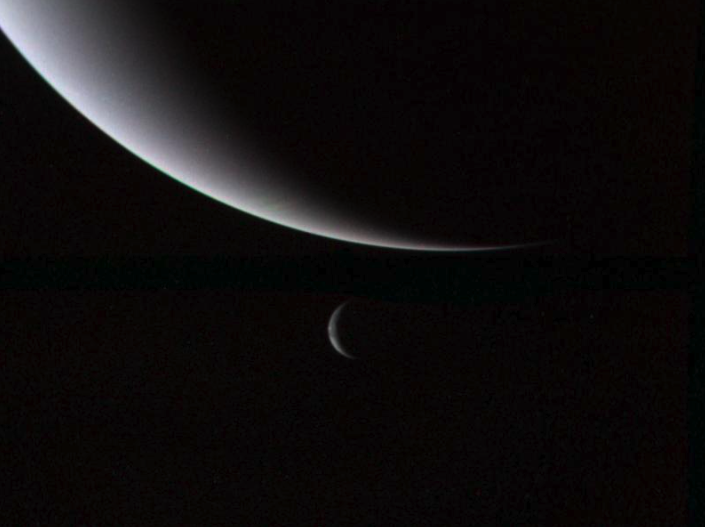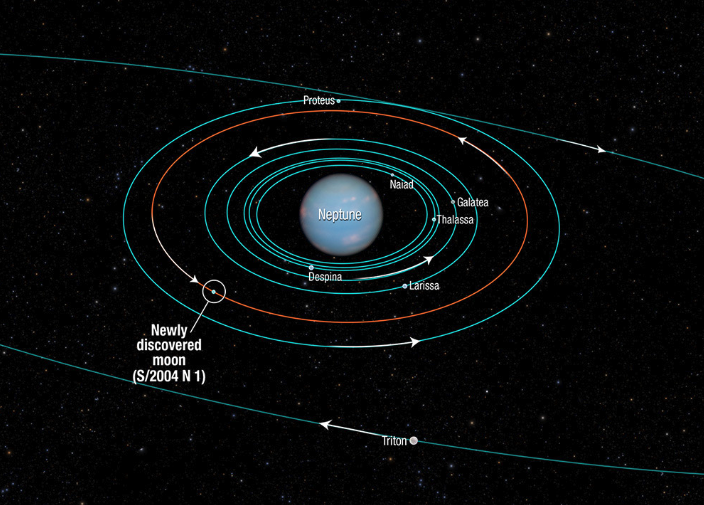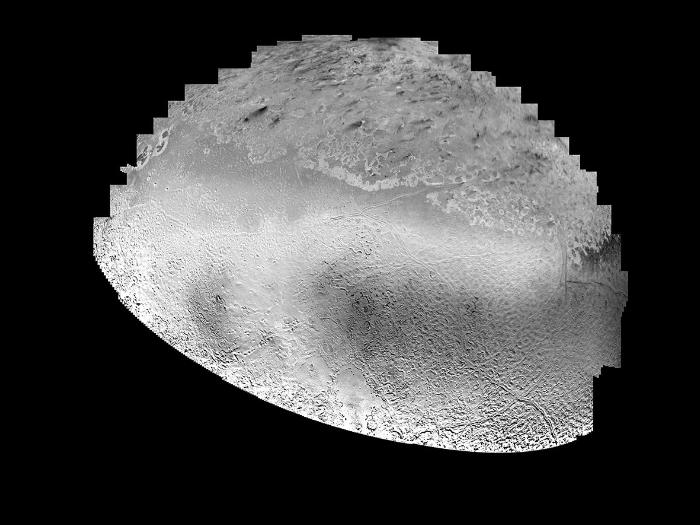Triton: Neptune’s Largest Moon
99.5% of all the mass orbiting around Neptune is part of the moon, Titan. Neptune’s largest moon, Triton, was discovered on October 10, 1846. English astronomer William Lassell found it just 17 days after the discovery of Neptune itself. Triton is the seventh-largest moon in the solar system and the only large moon with a retrograde orbit.

Table of Contents
Triton’s Characteristics
With a composition similar to Pluto and its retrograde orbit, scientists think Triton was a dwarf planet from the Kuiper Belt.
The Moon’s Size
Triton is a rocky, icy world with a diameter of about 1,700 miles (2,700 kilometers.) To put that in perspective, it’s about 4.7 times smaller than Earth but nearly the size of our moon. Triton is also larger than the dwarf planet Pluto.
Because of its large size, astronomers believe Neptune’s other moons probably formed after Triton’s capture. Moreover, they believe the capture event would have significantly disrupted or destroyed any satellite system around the planet. So the moons we see today are smaller and likely newer than Triton.
The Moon’s Makeup
Triton is full of volcanic activity caused by the Sun’s heat.
- A thin atmosphere of icy nitrogen and methane
- Rock and metal core.
- The surface consists of smooth volcanic plains.
- Mountains and craters are formed by frozen lava flows.
The moon’s density is twice that of water, higher than most other outer planet moons. The higher density likely signals a very rocky core.

The Moon’s Orbit
Triton’s retrograde orbit means it travels in the opposite direction to the planet’s rotation. This orbit direction is likely due to Triton being a captured object rather than a moon formed with Neptune.
Another orbital fact is that, like Earth’s moon, Triton and Neptune share a synchronous rotation. So one side of Triton’s face is constantly exposed to Neptune.
But unlike our moon, Triton’s orbital inclination means its poles alternate turns facing the Sun. Since Neptune takes 165 Earth years to travel around the sun, each of Triton’s polar regions spends about 80 years soaking up the solar heat.
Is There Life on Triton?
Does Neptune’s moon, Triton, bear consideration as humans continually seek the possibility of life in outer space? Probably not.
The moon has mild winds, similar to our moon. But due to the thin atmosphere, you probably wouldn’t feel them. However, when Voyager 2 flew over Triton in 1989, it measured the moon’s temperature at -391 degrees Fahrenheit (-235 degrees Celsius.) So the surface is too cold for life as we know it to exist.
The spacecraft measured the moon’s atmospheric pressure at 20,000 times less than Earth’s surface pressure. And finally, Triton has shallow gravity, about eight times lower than ours.
If life on Triton were possible, it wouldn’t be like life on Earth. For example, even if you lived on Triton’s “sunny pole” for its eighty-year stretch, you would still receive no benefit from the sun’s warmth.
On the other hand, if you lived in an area of Triton that does experience night and day, the Sun would only be a tiny blip on your horizon. And because of Triton’s retrograde orbit, you would see the faraway Sunrise in the west and set in the east, opposite to what we see on Earth.

How The Moon Got Its Name
This moon’s name comes from the Greek demi-god and merman, Triton. Half man and half fish, he was the son of Amphitrite and Poseidon (Neptune.) Since all Neptune’s moons have names from the Greek water gods and nymphs, Triton fits.
Additionally, Triton was known simply as “the satellite of Neptune” until Neptune’s second moon, Nereid’s discovery in 1949.
Conclusion
Triton is Neptune’s first discovered and largest moon. Its freezing temperatures make it uninhabitable to life as we know it, even though its surface shows smooth areas. This icy moon likely began as a dwarf planet before Neptune forced it into her orbit.
